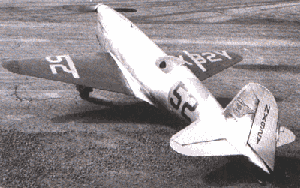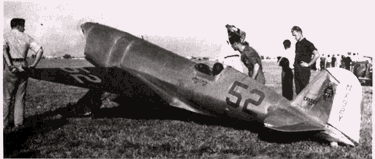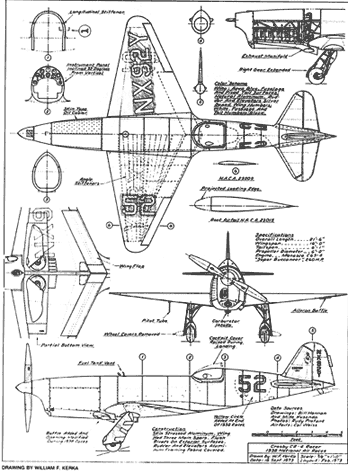


Crosby CR-3 - $$4.95
A sour engine, exposed wheel wells and an open cockpit restricted performance to just 226.075 mph entered the Thompson race and finished in sixth place. While recuperating from-very serious injuries that included a broken back, Crosby designed a much more refined racer, the CR-4.
The 1936 Crosby CR-3 and CR-4 Racer

 The all metal Crosby racer piloted by designer Harry Crosby to fourth place in the 1939 Thompson at 244.522 mph. Engine ans gear trouble continually plagued the racer and it's true potential was never realized.
The all metal Crosby racer piloted by designer Harry Crosby to fourth place in the 1939 Thompson at 244.522 mph. Engine ans gear trouble continually plagued the racer and it's true potential was never realized.
This Racer is especially appealing for it's open cockpit placed far to the rear of the fuselage. The nose is a little tricky but, when done carefully, is fantastic!
To whom it may concern: I found your web site during a search for info on the Keith Rider R4 and was very interested in your Crosby CR4. The plane was recently restored and is now on display.
The model on your web site is actually the CR4 which was rebuilt from the crashed CR3's components. Regards, Chuck
Howdy!
Great Balls A Fire! For the past few months (actually years)
I have been helping veteran pilots and crew members, one of
which has been my passenger attending the second Sunday of
the month B-17 Combat Crew members Organization meetings at
Long Beach Airport, California.
Last Sunday, Col Bruce Bauer and I were chatting on the return
drive and he mentioned the Crosby racing plane. Bruce was one of the top three designers on
the P-38 and other aircraft so we usually beat that horse
to death, but he made a comment about the Crosby that perked
my ears; hey- Fiddlers Green has a model of the Crosby CR-3!
Originally the Crosby racer had a four banger for an engine.
At the time Bruce was an instructor for Curtis Wright Technical.
Bruce designed placement for a six cylinder Menasco, removed
the external cooler, and designed the cowling for proper engine
cooling with reduced drag. He told about Crosby winning third
place but believed he should have been awarded first. They
did have problems with the cowling leaking so this kept Bruce
busy.
According to Bruce, Crosby went to work for Northrop as a
test pilot on the Flying Wing. Crosby was told to do a demonstration
fly-by but Crosby, on his own, decided to loop the Wing ..too
low.
BTW Bruce is ninety-four years old.
Just had to share this. I will build the Fiddlers Green Crosby
CR-3 and present it to him next month. That should be a kick
because he has no idea there is a paper model available.
Bob Penikas

Harry Crosby's CR-3

 First flight was April 1938. Aircraft
was very clean aerodynamically and was fast. If all systems were "go"
it could have dominated competition. Engine and gear problems
surfaced continuously and Crosby had to drop out of both the Greve
and Thompson in 1938. 1939 was not much better. In the Greve he
was flagged down in the 13th lap averaging only 164.87 mph, but
was awarded third place. He took fourth in the Thompson at 244.522
mph. Remains of the CR-4 were discovered recently in North Carolina
and the racer will be restored for display at the EM Air Adventure
Museum.
First flight was April 1938. Aircraft
was very clean aerodynamically and was fast. If all systems were "go"
it could have dominated competition. Engine and gear problems
surfaced continuously and Crosby had to drop out of both the Greve
and Thompson in 1938. 1939 was not much better. In the Greve he
was flagged down in the 13th lap averaging only 164.87 mph, but
was awarded third place. He took fourth in the Thompson at 244.522
mph. Remains of the CR-4 were discovered recently in North Carolina
and the racer will be restored for display at the EM Air Adventure
Museum.
The 1938 Crosby CR-4 racer. The CR-4 was the brainchild of Harry V. Crosby, a barnstormer, airmail pilot, and test pilot who was killed trying to bail out of the Northrop XP-79B jet flying wing in 1945. He was also apparently an incredible fast talker, as he managed to have the CR-4 design wind-tunnel tested in the Guggenheim lab at Cal Tech for free, as well as having students at the Curtiss-Wright Technical Institute build it for free. And just for good measure, he managed to talk a Texas oilman into financing the operation.

So, while most of his competition was flying planes covered with plywood and fabric that had been designed by the eyeball method, some still sporting wire bracing on wings and tail, Crosby's sleek all-metal racer was obviously one of the most advanced and fastest planes in the world. However, this was not enough to make the plane a success, as it suffered from constant mechanical woes. Originally designed to take a Ranger V-12 engine, which became unavailable to Crosby, he instead installed a Menasco C6S-4 from a previous racer, the Crosby C6R-3 (see pictures below). While the plane was still extremely fast with the smaller engine, that specific engine was prone to erratic performance. Another problem with the plane was its weight.
As it was designed for the more powerful Ranger, its weight with the Menasco was about 600 lbs. heavier than the Folkerts SK-4, which was about the same size and used the same engine. This extra weight, coupled with the tiny wing, made the plane very poor at pylon turns. Also a major headache was the landing gear, which was operated by a CO2 fire extinguisher. Empty extinguisher bottles and leakage made the gear prone to extending any time the airplane was turned hard. The CR-4's racing record: 1938 Greve - out; 1938 Thompson - out; 1939 Greve - flagged down on 13th lap, 164.9 mph, 3rd place; 1939 Thompson - 244.5 mph, 4th place.
 Apparently, there was still some "snort" left in the
design, as I have read that there where plans to install a Ranger
V-12 in the CR-4 and enter it in
the 1947 National Air Races. This never transpired, however, and
the airplane effectively disappeared shortly thereafter. Efforts
to trace the plane's whereabouts were futile until 1990, when
Morton Lester heard about a lady in North Carolina selling some
old aircraft parts, which had been collected by her late husband.
The first part of the collection consisted of parts for 6-cylinder
Menasco engines, which were most often found under the cowls of
racing aircraft. Next was a weather-beaten aluminum fuselage and
wing center section resting on the rotted remains of sawhorses
in a nearby woods.
Apparently, there was still some "snort" left in the
design, as I have read that there where plans to install a Ranger
V-12 in the CR-4 and enter it in
the 1947 National Air Races. This never transpired, however, and
the airplane effectively disappeared shortly thereafter. Efforts
to trace the plane's whereabouts were futile until 1990, when
Morton Lester heard about a lady in North Carolina selling some
old aircraft parts, which had been collected by her late husband.
The first part of the collection consisted of parts for 6-cylinder
Menasco engines, which were most often found under the cowls of
racing aircraft. Next was a weather-beaten aluminum fuselage and
wing center section resting on the rotted remains of sawhorses
in a nearby woods.
While it certainly resembled the still unaccounted-for
CR-4, there was no engine, cowl, outer wing panels, canopy, control surfaces, registration numbers, or
any other reliable identification. Mr. Lester proceeded to search
the rest of the property for more parts and found some (cowl parts,
as I recall), but still nothing conclusive regarding the ID of
the fuselage in the woods. Mr. Lester took one last look at the
property, making sure he hadn't missed anything, when he noticed
two old bus bodies in the woods. Why put a bus in the woods? To
store things, of course!
Sure enough, the control surfaces, canopy, landing gear doors, and outer wing panels were stashed in there. One of the wing panels had half of the CR-4's NX92Y registration number on it , so the identity of the airplane was confirmed. And if that story wasn't lucky enough for you, consider the fact that the lady who had the CR-4 was just days from having the "junk" cleared from her property. Just the thought makes me shudder. Since then, the CR-4 has been under restoration, first by Mr. Lester and his crew, and more recently completed by the EAA Air Adventure Museum restoration staff. in Oshkosh, WI. Currently, the aircraft is on display in the EAA Air venture Museum.


 |
Clear Cabin Crosby CR-3 Racer submitted by Bob Martin. Thanks Bob! |


